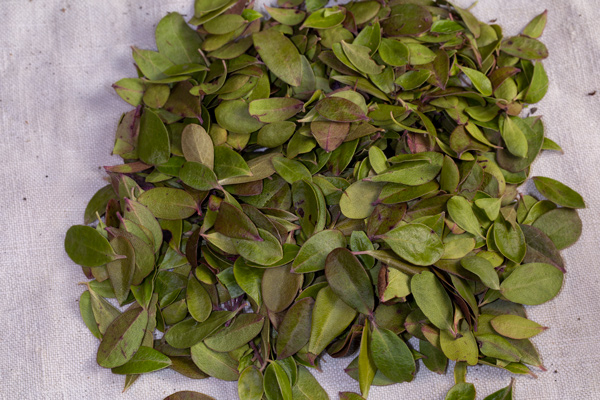Traders arrive at the Knife River Villages with news of the Arikaras and Sioux and two plant specimens for Lewis. About six miles from Fort Mandan, several enlisted men cut down cottonwood trees to make dugout canoes.
Sacacomis and Indian Remedy
by Yellowstone Public Radio[1]Originally aired weekdays by Yellowstone Public Radio during the Bicentennial observance of 2003-2006. Narrated by Hal Hansen. Scripts by Whit Hansen and Ed Jacobson. Produced by Leni Holliman. © … Continue reading
Dried Bearberry Leaves
Arctostaphylos uva-ursi
© 2014 by Kristopher K. Townsend. Permission to use granted under the Creative Commons Attribution-Share Alike 4.0 International license.
Narrow-leaved Purple Coneflower
Echinacea angustifolia
© 2011 by Kristopher K. Townsend. Permission to use granted under the Creative Commons Attribution-Share Alike 4.0 International license.
Bearberry and Echinacea
two men of the N W Compy arrve with letters and Sacka comah also a Root and top of a plant presented by Mr. Haney, for the Cure of mad Dogs Snakes &c,
—William Clark
Arikara Pacification
Mr. Gravelin two frenchmen & two Inds. arrive from the Ricara [Arikara] Nation with Letters from Mr. Anty Tabeaux [Pierre-Antoine Tabeau], informing us of the peaceable dispositions of that nation towards the Mandans & Me ne ta res [Hidatsas] & their avowed intentions of pursueing our Councils & advice, they express a wish to visit the Mandans, & Know if it will be agreeable to them to admit the Ricaras to Settle near them and join them against their common Enimey the Souis
—William Clark
Sioux Aggression
Mr. Gravilin informs that the Sisetoons and the 3 upper bands of the Tetons [Lakota Sioux], with the Yanktons of the North intend to come to war in a Short time against the nations in this quarter, & will Kill everry white man they See—
—William Clark
News of Recent Robbers
they all Informed us that they Saw the Souix Savvages who Robed our men of the 2 horses, & they said their was 106 in nomber and that they had a mind for to kill our men & that they held a counsel over them whether to kill them and take their arms and all or not. but while they were doing that our men were off and got clear, but they Say if they can catch any more of us they will kill us for they think that we are bad medicine and Say that we must be killed.
—John Ordway
Felling Cottonwood Trees
in the evening the men returned who had been cutting trees to day for the perogues. they Said they had Several good trees cut, but had Broke Several of their axes.—
—John Ordway
Weather Diary
State of the Ther. at rise
Weather Wind at rise
Thermt. at 4 oCk. P.M. Weather Wind at 4 oCk. P.M. River 24 [above 0] fair E 38 [above 0] cloudy S E Mr. Gravlin arrived with some Ricaras & two frenchmen
—Meriwether Lewis[2]To assist the reader, the editor of this web page has omitted the date column, merged the “State of the River atrise” columns, and spelled out some abbreviations.
Experience the Lewis and Clark Trail
The Lewis and Clark Trail Experience—our sister site at lewisandclark.travel—connects the world to people and places on the Lewis and Clark Trail.
Plan a trip related to February 28, 1805:

Fort Mandan is a High Potential Historic Site along the Lewis and Clark National Historic Trail managed by the U.S. National Park Service. The North Dakota Department of Parks and Recreation manages a modern reconstruction and the Lewis and Clark Interpretive Center located at US Hwy 83 and ND Hwy 200A.
Knife River Indian Villages National Historic Site is a High Potential Historic Site along the Lewis and Clark National Historic Trail managed by the U.S. National Park Service. A unit of the National Park System, the site is located at 564 County Road 37, one-half mile north of Stanton, North Dakota. It has exhibits, trails, and a visitor center.
Notes
| ↑1 | Originally aired weekdays by Yellowstone Public Radio during the Bicentennial observance of 2003-2006. Narrated by Hal Hansen. Scripts by Whit Hansen and Ed Jacobson. Produced by Leni Holliman. © 2003 by Yellowstone Public Radio. |
|---|---|
| ↑2 | To assist the reader, the editor of this web page has omitted the date column, merged the “State of the River at  rise” columns, and spelled out some abbreviations. rise” columns, and spelled out some abbreviations. |




